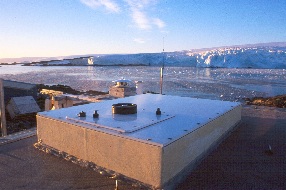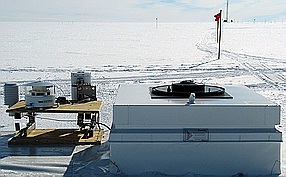New from Biospherical Instruments Inc.GUV-2511 surface ultraviolet-visible light radiatorIt is a widely used combination of GUV-511 and GUV-541.Similar to the latter two, the GUV-2511 is also very suitable for long-term monitoring.GUV-2511 can be measured6 key wavelengths of ultraviolet (UV) radiation: 305, 313, 320, 340, 380 and 395 nm,as well asPhotosynthetic effective radiation (PAR, 400-700 nm).GUV data can be used to invert cloud optical thickness and total ozone column volume—two key parameters when building solar spectral models. Biosphere Instruments is a pioneer in the design and manufacture of surface and underwater ultraviolet radiation sensors.The company is responsible for designing and maintaining the UV radiation monitoring network established by the U.S. Natural Science Foundation.The core of this network is Biosphere’s SUV-100 spectroradiometer, an instrument that can measure high-resolution ultraviolet spectral radiation.The SUV-100 proves its outstanding capabilities at multiple sites, including three sites in Antarctica, one site in Argentina and two sites in the United States (Barrow in Alaska and San Diego in California). The GUV series, completed with the support of the U.S. Navy’s Small Business Innovation Research (SBIR) project, is an upgraded product of the SUV-100 (more cheaper and portable) to monitor key wavelengths of surface UV radiation.Since its birth in 1992, the GUV series has been widely used all over the world. |
|
Key Features
ComeMeasure 6 key wavelengths of surface ultraviolet radiation: 305, 313, 320, 340, 380 and 395 nm
ComeMeasurement of Photosynthetic Effective Radiation (PAR)
ComeSpecially made high-precision low-noise sensor, special interference filter is ideal for detecting UV-B (290-320 nm) and UV-A (320-400 nm)
ComeAluminum alloy shell is durable and can be measured in the field for a long time
ComeIt has an excellent temperature insulation layer, which can ensure normal internal temperature of the instrument even if the external temperature changes violently
ComeBuilt-in sensors can measure the temperature of the photodiode array
ComeUse the RS-232 interface to connect to the computer to transmit data
ComeCan be used alone or in monitoring networks
ComeApplication software based on Windows operating system
The UV radiation monitoring network of the US Natural Science Foundation of China (NSF) was established in 1987. In 1988, Biosphere installed the first radiation sensor for it and has been responsible for installing and maintaining the entire network to this day.The network provides a large amount of reliable data for ozone layer hollow research, terrestrial and marine ecosystem research.
Instrument model | Use site |
SUV-100 spectroradiometer | McMurdo, Palmer, South Pole, Ushuaia, San Diego and Barrwo |
SUV-150B spectral radiator | summit |
GUV-511 multi-channel radiation meter | McMurdo, Palmer, San Diego, Barrow and Summit |
GUV-541 multi-channel radiation meter | south Pole |
Eppley PSP radiation meter | All sites |
Eppley TUVR type radiation meter | McMurdo, Palmer, South Pole, Ushuaia and Barrow |
|
|
Application of SUV-100 in Palmer Station | Application of SUV-150B, GUV-511 and PSP radiometers in Summit Station |
Technical parameters
Physical indicators
size: 15 cm (width) x 30 cm (height)
Material: 6061 T6 aluminum alloy, outer insulation Teflon sleeve.Double-layer jacket and shielded plastic can effectively prevent electromagnetic wave interference, while making the internal temperature more stable.
weight: 7 kg
Ambient temperature range: -50℃~+40℃
Photodiode array temperature:40℃~±0.5℃
sensor
standard: Downlink radiation and internal temperature sensor (used to monitor the temperature of the photodiode array)
Optical properties
Measure wavelength: 305, 313, 320, 340, 380, 395 nm and PAR (400-700 nm)
bandwidth: Standard 10 nm FWHM, optional 20 nm FWHM
Photodiode detector
Filter type: Low fluorescence interference filter
Cosine current collector: Teflon-coated quartz, diameter 2.1 cm
Out-of-band suppression: 1 small 10-6
Response value:0°-70°Time: 0-5%; 71°-85°hour:±10%
Saturation value:105withoutW Silence-2So-1
Noise equivalent irradiance:10-11W Silence-2So-1
Temperature drift:<±3withoutV/℃
Temperature stability
When the ambient temperature is low, the heating function is automatically cut off when the ambient temperature is high. Combined with the heat insulation device, the internal working temperature of the packaging can be effectively constant.
Electronic system
System sampling frequency: 20 Hz
Inter-channel sampling delay:500withoutyes±175 You are
Data collection
Gain and 16-bit A/D conversion: Full scale 10 V and 1.3withoutV/LSB; 10 range selections, manual selection or automatic identification.
Output: 2-bit RS-232; 9600 White Paper
Desktop controller
size: 43 cm (width) x 30.5 cm (length) x 7 cm (height)
Material:Aluminum alloy
powered by: AC (85-264 V/47-63 Hz)
Temperature controller: Programmable transistor digital temperature controller
cable
GSC-511 type anti-atmospheric corrosion cable, length up to 100 m, need to be purchased separately
software
Data acquisition software based on Windows operating system
calibration
Calibration was performed using the National Institute of Standards (NIST) traceable certification method.Calibration can also be performed using a high resolution scanning spectroradiometer.Calibration is recommended once a year.
Representative literature
Booth, C.R., T.B. Lucas, J.H. Morrow, C.S. Weiler, and P.A. Penhale (1994). The United States National Science Foundation’s polar network for monitoring ultraviolet radiation, inAntarctic research series, edited C.S. Wei rand P.A. pen Hale, American geophysical union, Washington, DC.
booth, C.R., J.H. Morrow, DD.A. NE US except R (1992). anew profiling spec days RO radiometer optimized for use int and ultraviolet.SP IE Vol. 1750ocean optics ξ: 354-365.
l u bin, D., J. Frederick, C. booth, T. Lucas, D. NE US except R (1989).measurements of enhanced springtime ultraviolet radiation at Palmer station, Antarctica.Geo Phys. Res. Lett.16:783-785.
s NES, K., J. S Rd. 32, and M. Bowen (1991). derivation of total ozone abundance and cloud effects from spectral irradiance measurements.applied optics30(30):4418-4426.


